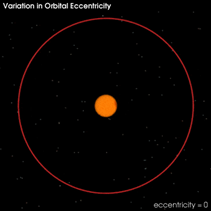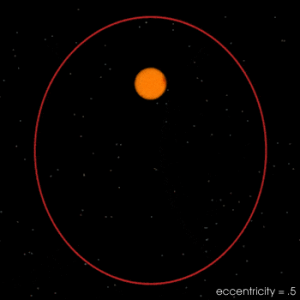L’excentricité
L’excentricité décrit la forme de l’orbite de la Terre. Au fil du temps, l’excentricité de l’orbite de la Terre passe d’un cercle presque parfait à un ovale, et puis revient à un cercle. Il faut 100 000 ans pour que l’orbite accomplisse un cycle orbital entier.
En hiver, l’orbite est presque circulaire, la Terre étant un peu plus proche du Soleil en janvier qu’elle ne l’est en juillet. Par conséquent, à ce moment-là, l’excentricité de l’orbite a très peu d’effet sur le climat de la planète pendant une année.
Cependant, si l’orbite était un ovale prononcé, l’excentricité serait un facteur dominant affectant le climat, la Terre étant plus chaude quand elle était plus proche du Soleil. La différence entre les saisons serait également plus prononcée.




 This project (EDU-ARCTIC) has received funding from the European Union’s Horizon 2020 research and innovation programme under grant agreement No 710240. The content of the website is the sole responsibility of the Consortium and it does not represent the opinion of the European Commission, and the Commission is not responsible for any use that might be made of information contained.
This project (EDU-ARCTIC) has received funding from the European Union’s Horizon 2020 research and innovation programme under grant agreement No 710240. The content of the website is the sole responsibility of the Consortium and it does not represent the opinion of the European Commission, and the Commission is not responsible for any use that might be made of information contained.